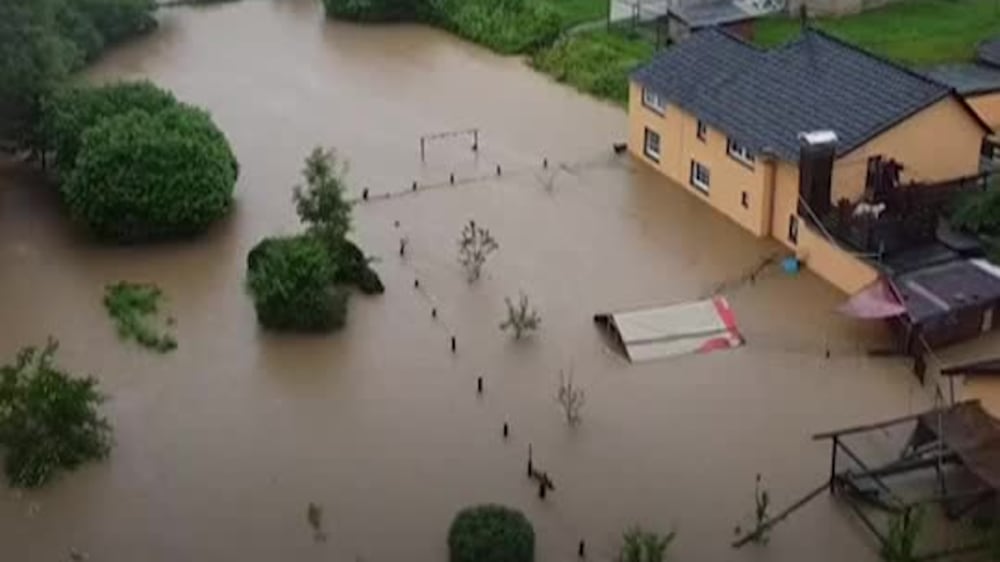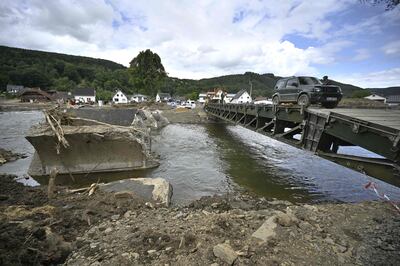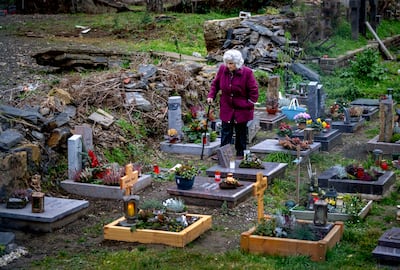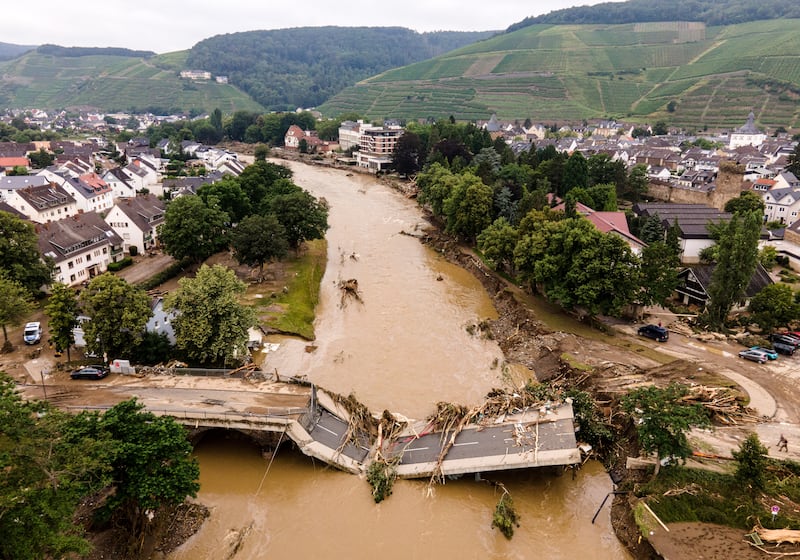Germany’s Ahr valley is a postcard-perfect landscape of sloping vineyards, rugged walking trails and idyllic towns with timber houses and medieval squares – but it bears the scars of the night when nature became its enemy.
Locals awoke to devastation on July 15, 2021, after the River Ahr burst its banks and its rampant waters went barrelling through cobbled streets. The town of Bad Neuenahr-Ahrweiler was ground zero of a flood disaster that killed more than 200 people across Germany, Belgium and the Netherlands.
Within hours, they were calling it a once-in-a-century calamity.
But climate change means yesterday’s once-in-a-century is becoming tomorrow’s much-more-often, and the town is rebuilding in the knowledge that it must be better prepared next time.
“If something like that happens again, the valley will be empty,” Mayor Guido Orthen told The National while celebrating the reopening of the first of six sports grounds devastated by the floods.
Then and now: a town hit by floods
The revamped football and hockey ground is an example of what Mr Orthen calls a “new, different normality”.
Modernised with LED floodlights, and cleaned out after the water rose to head-height in the referee’s changing room, the new €1.2 million ($1.32 million) pitch has adjustable fencing that would be lowered if a flood alarm sounds.
Lowered, not raised – parks and sports grounds would effectively be used as safety valves to prevent a bursting river from taking a deadlier path.
Snowball effect
It is a bitter lesson from the night of the floods, when extreme rainfall swelled the Ahr, a tributary of the Rhine, and soil was too saturated and the riverbed too clogged for the water to run off.
The result was an immense backlog of pressure that would tear through one bridge, accumulate yet more debris and hit the next one with even more force. This snowball effect is believed to have heightened the peak flooding by as much as 3 metres.
In another adaptation measure in the aftermath, temporary bridges put up by the army were built without pillars to keep the river’s path clear. Some are still there, even where the Ahr is at such a trickle that you could think you were in the wrong place.
Severe flooding kills dozens in Germany

On dry land, it is clear that Bad Neuenahr is still recovering, even as people enjoy cakes and cold drinks in the town square. Some shops are still boarded up. Others have signs declaring defiantly that “we are back”, “we are still here”, even with a bit of wordplay borrowing from English: “We AHR united.”
Even the most pessimistic local would not have thought the river could reach so high, said Cornelia Kilian, a tour guide. People awoke to find basements and cellars flooded in old timber houses.
Schools, kindergartens and hospitals were hit, roads were destroyed and insurers said their €8.75 billion ($9.6 billion) bill was their highest ever for a natural disaster in Germany.
In another preventive measure, electrics are being moved into attics where even the most extreme floods will not damage them. Historic buildings – the town has a church with records of local tithes from 1269 – are being restored.
Rebuilding from ruins is part of almost every German family’s story after the horrors the 20th century brought. The Ahr is no different – Allied bombs fell on the valley in 1945, possibly aiming at a V2 rocket factory nearby. Yet while peace has prevailed for decades, high waters are an ever greater threat.
Climate threat
Scientists at World Weather Attribution said the Ahr’s extreme rain was up to nine times more probable because of global warming. Experts say such events will only become more probable as climate change intensifies.
In a nod to the Ahr disaster, July 15 was declared by the EU as a Day for the Victims of the Global Climate Crisis at a Brussels ceremony attended by UN chief Antonio Guterres.
The fateful date should forever “serve as a moment of reflection on the human toll of the climate crisis”, said Frans Timmermans, the EU commissioner responsible for climate action.
Mr Orthen is clear that climate change is threatening his town.
“These things have always existed, but now they come more often,” he said.
The floods also played an outsize part in German political history. Armin Laschet, at the time the favourite to succeed Angela Merkel as chancellor, never recovered from a gaffe when a camera caught him chuckling in the background during sombre speeches in the flood zone. Two months later, he narrowly lost a general election to Olaf Scholz.

Like Mr Scholz’s government, the Ahr valley wants to do its part in stopping climate change as well as preparing for the worst. Four towns have brought in modern district heating systems. A storm-ravaged railway line will run on electricity rather than diesel when it fully reopens in 2025.
But the global temperature rise is out of the valley’s hands and it has to be ready if the floods return. Efforts are being made to improve a system of warning sirens that were widely criticised in 2021.
Paying for these improvements can be an issue, and dedicated recovery funds are really meant to restore what was there before, Ms Kilian said – not be misused for “golden taps”.
And there are lines that will not be crossed, because climate hazards or not, the Ahr is a site of natural beauty where people still want to come and visit, relax or retire.
Tourists are coming back and local hotels are in high demand. The interior minister of the state of Rhineland-Palatinate, Michael Ebling, said the stadium’s reopening was a “point of light”.
“Yes, we still have a huge amount ahead of us, but I think within this huge amount we will be able to show a host of successes,” he said.

A graveyard on the riverbank took the full force of the disaster, but there is no appetite for a huge, incongruous flood wall at the cemetery.
Mr Orthen would like to do more but says there is a lack of money and political will to re-engineer the valley, whose steep, narrow course was blamed for the flood’s vicious advance.
“Nobody is doing it yet. We are a low-lying area here, we lie downstream. We have essentially done our homework when it comes to containment measures. The upper and middle Ahr unfortunately haven’t yet,” he said.
“Our containment measures have taken 20 years of planning. Only we don’t have that time.”
Extreme weather is never far away – even when the Ahr is ankle deep. Two years to the day since the flood, Germany issued a heatwave warning and authorities in the region spoke of “tropical nights” due to climate change. Even when it never rains, it pours.






